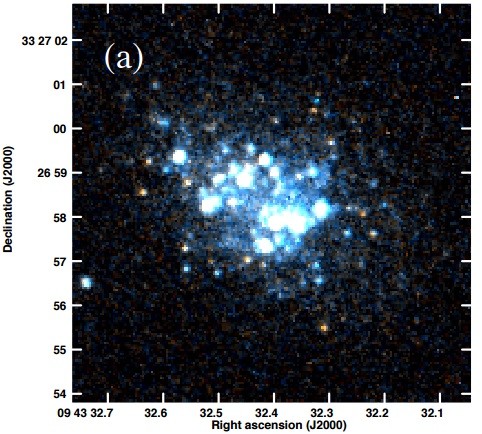Mysterious Faint Galaxy With Lowest Metals Ever Provide Clues About Big Bang
| Ana Verayo | | May 13, 2016 04:52 AM EDT |
(Photo : Hirschauer et al., 2016./Hubble/NASA) Hubble Space Telescope (HST) image of AGC 198691, created using 20 minute exposures obtained through the V (F606W) and I (F814W) filters.
Astronomers just recently discovered a mysterious, faint blue galaxy about 30 million light years away from Earth, that can reveal clues about the evolution and history of the universe, from the first light that shone after the Big Bang.
Scientists from Indiana University detected this rather small, tenuous galaxy that appear to be a regular spiral galaxy at first. However, the chemical composition and heavy elements present in the galaxy makes it unique, as researchers name it Leoncino or the Little Lion.
Like Us on Facebook
Formally known as AGC 198691, this small galaxy is so unique, that astronomers believe that this is the only known galaxy in the universe that has been observed to possess the fewest metal elements that is functioning like a regular stellar system.
According to astronomy professor, John J. Salzer from the Indiana University, this has been an exciting discovery since this is the most metal-poor galaxy ever detected that can be linked to clues about the Big Bang event. There are have been a few ways to investigate conditions of the universe during its birth some 13.8 billion years ago, however it is crucial and most promising to examine low metal galaxies such as this one.
Galaxies that are located relatively close to the Milky Way possess high levels of metal elements. Heavier elements are forged inside the burning cores of stars which means that every new generation of stars produce new kinds of elements.
Right after the Big Bang event, the universe did not contain any heavy metals, and galaxies such as the Leonicino, can provide a glimpse of these conditions about the infant universe, giving astronomers the rare opportunity to test their current models of the Big Bang. Scientists are curious to test out how much helium and hydrogen were present during this time.
By using spectography techniques, researchers obtained measurements of the chemical compositions of distant star systems. A galaxy's star formation rate and abilities are often presented with heavy metal ratios, and Leoncino is expected to be in the low end.
This galaxy is also smaller than the average galaxy, spanning around 1,000 light years, almost fitting into the dwarf galaxy category. The Milky Way possibly contains as many as 400 billion stars, where the Little Lion only possesses a few million of them.
Researchers also add that these stars are are relatively young ones and extremely hot, however, the galaxy is unusually the least brightest of its kind, emitting a faint bluish glow. Salzer says that further research is needed to investigate the low metal composition of the Leoncino, however, low metal galaxies are extremely rare, which makes this one of the first.
AGC 198691 is first discovered by the Arecibo Legacy Fast ALF (ALFALFA) radio survey project.
This new study is published in The Astrophysical Journal.
Tagsbig bang event, mysterious faint blue galaxy, Universe, evolution of universe, galaxies
©2015 Chinatopix All rights reserved. Do not reproduce without permission
EDITOR'S PICKS
-

Did the Trump administration just announce plans for a trade war with ‘hostile’ China and Russia?
-

US Senate passes Taiwan travel bill slammed by China
-

As Yan Sihong’s family grieves, here are other Chinese students who went missing abroad. Some have never been found
-

Beijing blasts Western critics who ‘smear China’ with the term sharp power
-

China Envoy Seeks to Defuse Tensions With U.S. as a Trade War Brews
-

Singapore's Deputy PM Provides Bitcoin Vote of Confidence Amid China's Blanket Bans
-

China warns investors over risks in overseas virtual currency trading
-

Chinese government most trustworthy: survey
-

Kashima Antlers On Course For Back-To-Back Titles
MOST POPULAR
LATEST NEWS
Zhou Yongkang: China's Former Security Chief Sentenced to Life in Prison

China's former Chief of the Ministry of Public Security, Zhou Yongkang, has been given a life sentence after he was found guilty of abusing his office, bribery and deliberately ... Full Article
TRENDING STORY

China Pork Prices Expected to Stabilize As The Supplies Recover

Elephone P9000 Smartphone is now on Sale on Amazon India

There's a Big Chance Cliffhangers Won't Still Be Resolved When Grey's Anatomy Season 13 Returns

Supreme Court Ruled on Samsung vs Apple Dispute for Patent Infringement

Microsoft Surface Pro 5 Rumors and Release Date: What is the Latest?










